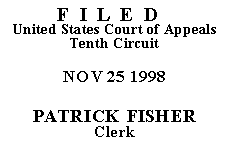

| IN RE: RUFF FINANCIAL SERVICES, INC.,
doing business as Ruffco, Inc.,
Debtor. _________________________ ROGER G. SEGAL, Trustee ,Plaintiff-Appellant,
v.
MARYJANE B. LEDYARD, H.L. WIGGINS,
SUE WIGGINS Defendants-Appellees. |
No. 97-4094
(D.C. No. 96-CV-798-B) (D. Utah) |
Ruff Financial Services, Inc. (Ruffco) was a Utah corporation that engaged in business as a precious metals dealer from 1985 until 1991. In 1986, Ruffco offered for sale sixty "units," each of which consisted of 50,000 shares of convertible preferred stock in Ruffco plus a $25,000 promissory note. The notes could not be bought separately from the shares. Their terms provided for 7.5% interest per annum, payable quarterly. The maturity date was June 1, 1989, but noteholders could demand immediate repayment after January 1, 1988, and prior to the maturity date at a 6% interest rate. Payment on the notes was subordinated to loans from financial institutions, but not to claims from general creditors.
In May 1989, Ruffco sent a "roll over" letter to the noteholders inviting them to defer payment on their notes for greater returns later. No noteholder chose deferment, and by June 1989 Ruffco had paid the balance on all of the notes. In May 1991, Ruffco filed a Chapter 11 petition for relief in bankruptcy court, which was later converted into a Chapter 7 petition. Mr. Segal was appointed as the Chapter 7 trustee. He filed suit against the noteholders, claiming that Ruffco's redemption of the notes violated Utah law.
Utah law provided at the time that "[n]o purchase of or payment for its own shares may be made at a time when the corporation is insolvent or when the purchase or payment would make it insolvent." Utah Code Ann. § 16-10-5 (5) (repealed 1992). It defined "shares" as "the units into which the proprietary interests in a corporation are divided." Utah Code Ann. § 16-10-2 (14) (repealed 1992 and re-enacted as Utah Code Ann. § 16-10a-102 (32) (1992)). The trustee claims Ruffco violated this statute when it redeemed the promissory notes. He argues that because the notes could only be purchased in a "unit" with stock shares, they are merely disguised shares which Ruffco redeemed while insolvent.
The Utah statute requires a "proprietary interest" for the notes to be shares. While it is clear that the stock portion of the unit conveyed such an interest, there is no evidence that the note portion did the same. Simply because defendants obtained both instruments through one transaction does not make the two instruments the same. On the contrary, the stock certificates and the promissory notes conveyed different types of interests carrying different amounts of risk.
Various tests exist to determine whether a note constitutes a loan or equity. The bankruptcy court applied the "family resemblance test" articulated by the Supreme Court in Reves v. Ernst & Young, 494 U.S. 56 (1990), as the appropriate way to determine whether promissory notes are securities under the Securities Exchange Act of 1934. The district court declined to apply that test, instead analyzing the notes under a multi-factored test used by circuit courts to decide whether an advance of money constitutes a loan for tax purposes.
We agree with the district court that the tax cases are more relevant to this case. The purpose of the statute at issue is to protect creditors, see Owyhee, Inc. v. Robbins Marco Polo, 407 P.2d 565, 567-68 (Utah 1965), whereas the purpose of the Securities Exchange Act is to protect investors, see Reves, 494 U.S. at 60-61. While the tax cases are not precisely on point, they deal with interests similar to those at issue here and, as such, guide our analysis. See Cenex, Inc. v. United States, 156 F.3d 1377, 1381-82 (Fed. Cir. 1998); Roth Steel Tube Co. v. C.I.R., 800 F.2d 625, 630 (6th Cir.1986); Bauer v. C.I.R., 748 F.2d 1365, 1368 (9th Cir. 1984); Stinnett's Pontiac Serv., Inc. v. C.I.R., 730 F.2d 634 (11th Cir. 1984).
While each tax case delineates a similar test, Stinnett's Pontiac sets forth the most comprehensive list of elements to consider in determining whether the notes constitute debt or equity:
(1) the names given to the certificates evidencing the indebtedness; (2) the presence or absence of a fixed maturity date; (3) the source of payments; (4) the right to enforce payment of principal and interest; (5) participation in management flowing as a result; (6) the status of the contribution in relation to regular corporate creditors; (7) the intent of the parties; (8) "thin" or adequate capitalization; (9) identity of interest between the creditor and stockholder; (10) source of interest payments; (11) the ability of the corporation to obtain loans from outside lending institutions; (12) the extent to which the advance was used to acquire capital assets; and (13) the failure of the debtor to repay on the due date or to seek a postponement.
730 F.2d at 638. Under this test, the promissory notes appear to constitute debt. For example, the notes were entitled "subordinated promissory notes," there was a fixed maturity date and fixed interest rate, the noteholders had a right to enforce payment, the notes were not subordinated to general creditors, the parties intended for the notes to be loans, Ruffco repaid the notes on time, and the notes conferred no voting rights.
In sum, we agree with the district court's characterization of the notes as loans, and AFFIRM.(1)
ENTERED FOR THE COURT
Stephanie K. Seymour
Chief Judge
*.This order and judgment is not binding precedent, except under the doctrines of law of the case, res judicata, and collateral estoppel. The court generally disfavors the citation of orders and judgments; nevertheless, an order and judgment may be cited under the terms and conditions of 10th Cir. R. 36.3.
1.Because we conclude the notes are loans, not shares, it is not necessary to address the other findings by the bankruptcy court.